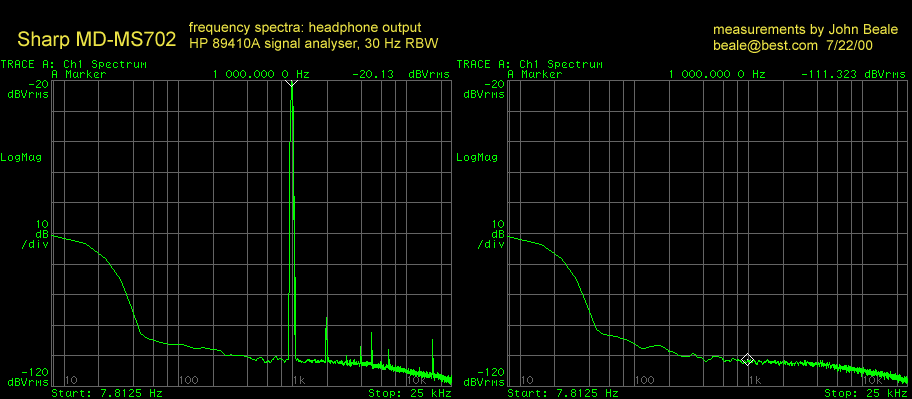
I bought a Sharp MD-MS702 portable MiniDisc recorder in 1998. It sounds a lot better than the Sony WM-D3 (recording walkman tape player) it's replacing, and it's smaller as well. I became interested in just how much better the noise is in particular, and below are some measurements. If you want to find out about Minidisc equipment in general, please visit the MiniDisc Community Page.
I recorded two tracks using the analog "line in" connector set at a record level of 28 (max is 30). I used a 440 Hz sinewave from a lab HP signal generator, adjusted so that the 702 showed a 0 dB recording level, which turned out to be 1.7 Vpp or 0.60 Vrms at the line in. The second track was just silence, no signal input. To avoid hum pick-up I had a 47 ohm resistor in series with a 10 uF capacitor on from the input signal to the input shield terminals (both channels).
To measure S/N ratio I measured the RMS output signal level at the headphone output from the 0dB level 440 Hz tone track and the RMS noise signal level from the "no signal" track and took the ratio. I did this for several settings of the headphone volume. The output on the quiet track was very small, so I used an external +60 dB low-noise preamp to increase the output signal before going to my DMM and scope.
The headphones bundled with the 702 unit, labelled "Sharp MD Stereo Headphones" have a DC resistance of 22 ohms on each side. The audio frequency impedance was not measured, but is probably higher (eg. 32 ohms). S/N measurements were taken with a 33 ohm resistive load on the headphone output, formed from 3 100 ohm resistors in parallel. I ran the unit off of the supplied wall adaptor. The output voltage on the headphone drops by 0.633 when loaded by 33 ohms relative to unloaded output, implying the output impedance of the headphone amplifier is 19 ohms.
And the bottom line... the highest S/N ratio I measured was
Quick tests on battery power vs. wall showed no measurable difference in noise level. The noise appears to be dominated by lower frequencies (not "white") and since the ear is less sensitive to very low frequencies, the perceived audio S/N ratio may be better than that shown here. My RMS multimeter is specified to 20 kHz bandwidth but I am not sure what the exact noise bandwidth is for this instrument. The noise of the battery-powered preamp I used for the "no signal" noise measurement is comfortably below the noise generated by the 702, at 0.9 uV referred to input, measured with all hookups in place but the 702 powered off.
Based on the S/N improvment with increasing volume setting, the S/N is dominated by the headphone output amplifier, and discs recorded on this unit and played back on a higher-quality unit might well show a better S/N. Apparently, each headphone volume step (from 1 to 30) is a 2 dB increase in output.
Volume Signal Noise S/N Ratio Setting mV RMS uV RMS dB ------------------------------------ 15 22.1 15.7 63.0 20 73.5 16.9 72.8 25 223.3 23.6 79.5 30 724.0 63.6 81.2 ------------------------------------
DUT: Sharp Portable MiniDisk Recorder MD-MS702 Serial No. 71200380 Equipment: HP 3312A function generator (source of 440 Hz sinewave) Tektronix DMM916 True RMS multimeter (20 kHz BW, <= 3 crest factor) Tektronix TDS210 60 MHz digital scope +60dB Preamp: PMI OP27 opamp (+40dB) & TL082C opamp (+20dB) input-referred noise of preamp (over entire audio band): 0.9 uVrms (the OP27 is actually better than that; most of the 0.9 uV is 60 Hz hum pickup due to unshielded wires but I didn't bother to fix that because it's already better than 20 dB below the measured signal.)
Disclaimer: I'm not a professional audio engineer. The results listed here may or may not correspond to accepted standards for S/N measurement. I believe the biggest unknowns are a) frequency response of my DMM in "True RMS AC" mode, and b) if the MD player circuits behave differently with an essentially empty track than one with full-amplitude program material.
I connected my MS702 MD recorder to a signal analyser, recorded a minute of 1 kHz sinewave from its source going to the line input of my recorder (line level in setting = 25, just under 0 dB indicated signal level). Then I recorded another minute of silence, actually a 50 ohm dummy load on the input, with the same level settings. I played back these two tracks into the analyser from the MD's headphone output with volume set to "25". The two plots below show the spectrum of the 1 kHz sinewave (image at left) and the silent track (right). I used the HP 89410A DC-10 MHz vector signal analyser with resolution bandwidth (RBW) of 30 Hz, with a 3201 point FFT covering 0-25 kHz. I set the main window to be "gaussian top". The plots below represent an RMS (video) exponential average of 100 sweeps.
Notice that the noise floor is about -111 dBVrms in a 30 Hz bandwidth. If you assumed the full audio spectrum to have a 15 kHz bandwidth (which is as much as I can hear) you have 500x more bandwidth and sqrt(500)=22.4x more Vrms noise, or 20log(22.4) = +27 dB. So, the full-scale 1kHz signal at -20 dBVrms from the headphone jack is 64 dB above the total RMS noise at -84 dBVrms. This measurement may be affected by the analyser's noise floor, as well as the MD player. Consider broadband noise to be an estimate. I'm not sure how an "A"-weighting filter would affect that value.